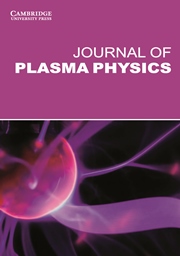Article contents
Mechanisms of plasma disruption and runaway electron losses in the TEXTOR tokamak
Published online by Cambridge University Press: 13 July 2015
Abstract
Based on the analysis of data from the numerous dedicated experiments on plasma disruptions in the TEXTOR tokamak the mechanisms of the formation of runaway electron (RE) beams and their losses are proposed. The plasma disruption is caused by a strong stochastic magnetic field formed due to nonlinearly excited low-mode-number magneto-hydro-dynamics (MHD) modes. It is hypothesized that the RE beam is formed in the central plasma region confined by an intact magnetic surface due to the acceleration of electrons by the inductive toroidal electric field. In the case of plasmas with the safety factor  $q(0)<1$ the most stable RE beams are formed by the outermost intact magnetic surface located between the magnetic surface
$q(0)<1$ the most stable RE beams are formed by the outermost intact magnetic surface located between the magnetic surface  $q=1$ and the closest low-order rational surface
$q=1$ and the closest low-order rational surface  $q=m/n>1~(q=5/4,q=4/3,\dots )$ . The thermal quench (TQ) time caused by the fast electron transport in a stochastic magnetic field is calculated using the collisional transport model. The current quench (CQ) stage is due to the particle transport in a stochastic magnetic field. The RE beam current is modelled as a sum of a toroidally symmetric part and a small-amplitude helical current with a predominant
$q=m/n>1~(q=5/4,q=4/3,\dots )$ . The thermal quench (TQ) time caused by the fast electron transport in a stochastic magnetic field is calculated using the collisional transport model. The current quench (CQ) stage is due to the particle transport in a stochastic magnetic field. The RE beam current is modelled as a sum of a toroidally symmetric part and a small-amplitude helical current with a predominant  $m/n=1/1$ component. The REs are lost due to two effects: (i) by outward drift of electrons in a toroidal electric field until they touch the wall and (ii) by the formation of a stochastic layer of REs at the beam edge. Such a stochastic layer for high-energy REs is formed in the presence of the
$m/n=1/1$ component. The REs are lost due to two effects: (i) by outward drift of electrons in a toroidal electric field until they touch the wall and (ii) by the formation of a stochastic layer of REs at the beam edge. Such a stochastic layer for high-energy REs is formed in the presence of the  $m/n=1/1$ MHD mode. It has a mixed topological structure with a stochastic region open to the wall. The effect of external resonant magnetic perturbations on RE loss is discussed. A possible cause of the sudden MHD signals accompanied by RE bursts is explained by the redistribution of runaway current during the resonant interaction of high-energetic electron orbits with the
$m/n=1/1$ MHD mode. It has a mixed topological structure with a stochastic region open to the wall. The effect of external resonant magnetic perturbations on RE loss is discussed. A possible cause of the sudden MHD signals accompanied by RE bursts is explained by the redistribution of runaway current during the resonant interaction of high-energetic electron orbits with the  $m/n=1/1$ MHD mode.
$m/n=1/1$ MHD mode.
Information
- Type
- Research Article
- Information
- Copyright
- © Cambridge University Press 2015
References
- 10
- Cited by

